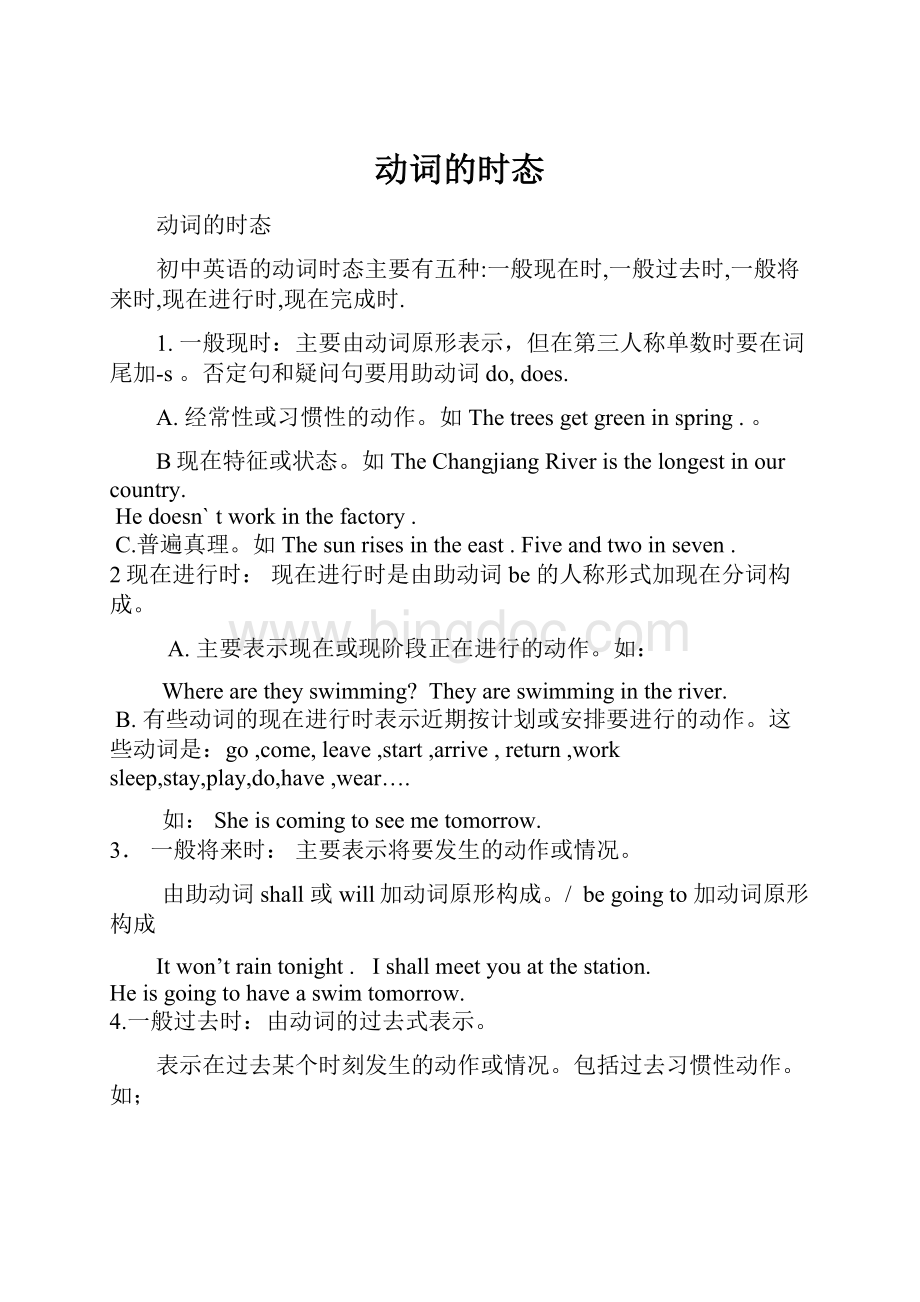动词的时态.docx
《动词的时态.docx》由会员分享,可在线阅读,更多相关《动词的时态.docx(11页珍藏版)》请在冰点文库上搜索。

动词的时态
动词的时态
初中英语的动词时态主要有五种:
一般现在时,一般过去时,一般将来时,现在进行时,现在完成时.
1.一般现时:
主要由动词原形表示,但在第三人称单数时要在词尾加-s。
否定句和疑问句要用助动词do,does.
A. 经常性或习惯性的动作。
如Thetreesgetgreeninspring.。
B现在特征或状态。
如TheChangjiangRiveristhelongestinourcountry.
Hedoesn`tworkinthefactory.
C.普遍真理。
如Thesunrisesintheeast.Fiveandtwoinseven.
2现在进行时:
现在进行时是由助动词be的人称形式加现在分词构成。
A.主要表示现在或现阶段正在进行的动作。
如:
Wherearetheyswimming?
Theyareswimmingintheriver.
B.有些动词的现在进行时表示近期按计划或安排要进行的动作。
这些动词是:
go,come,leave,start,arrive,return,worksleep,stay,play,do,have,wear….
如:
Sheiscomingtoseemetomorrow.
3. 一般将来时:
主要表示将要发生的动作或情况。
由助动词shall或will加动词原形构成。
/ begoingto加动词原形构成
Itwon’traintonight. Ishallmeetyouatthestation.
Heisgoingtohaveaswimtomorrow.
4.一般过去时:
由动词的过去式表示。
表示在过去某个时刻发生的动作或情况。
包括过去习惯性动作。
如;
Didyouknockatthedoorjustnow?
/ Hefinishedreadingthebookyesterday.
5.现在完成时:
由have的人称形式加过去分词构成
A到现在为止已经完成的动作。
如:
IhavelentmybooktoAnn.我把书借给了安。
Hehasneverseenarealtiger.他从来没有见过真老虎。
B、从过去开始延续到现在的动作或状态。
如:
Shehaslivedheresince1991.从一九九一年起她就住在这里。
时态 常用的时间副词:
一般现在时 every(year,otherday,twodays,week,month…),often,always,usually,sometimes,inthemorning,insummer,onSunday
一般过去时 lastweek,justnow,yesterday,yeaterdaymorning,thedaybeforeyesterday,then,atthatmoment,(afewdays)ago,
一般将来时 tomorrow,nextmonth,intwodays,
现在进行时 now
现在完成时 since,for(oneyear….),just,already,yet,inthelastfiveyears,…before.sofar
被动语态:
被动语态表示主语是动作的承受者。
由“助动词be+及物动词的过去分词”构成。
Be有人称,数量和时态变化。
一般现在时:
be(isamare)+及物动词的过去分词
一般过去时:
be(waswere)+及物动词的过去分词
情态动词的过去分词:
情态动词+be+及物动词的过去分词
宾语从句
宾语从句:
宾语从句在复合句中作主句的宾语。
由下列词引导,
1. 由that引导(that在口语中可省略)
Hesaid(that)hewouldliketoseetheheadmaster.
Shesaid(that)shewouldleaveamessageonhisdesk.
HewasafraidthathewouldforgethisChinese.
2. 接连接代词或连接副词引导.(what.who.which.whose /where,when,how……).
Doyouknowwhattimethetrainleaves?
Canyoutellmewhichclassyouarein?
Iwantedtoknowwhereweshouldshowourtickets.
3. whether或if引导
Lilywantedtoknowifitwouldrainthenextday.
SheaskediftheywouldgototheparkthisSunday.
*在选择疑问句中,或与ornot连用时,必须用whether而不能用if。
变宾语从句需要注意以下几点:
a. 时态变化:
主句是一般现在时,从句可以是任何时态
主句是过去时,从句必须是过去时态的一种
主句是将来时,从句必须是一般现在时。
B.人称变化:
不常用如:
Heaskedme.“Areyouateacher?
”
HeaskedmeifIwasateacher。
C.语序变化:
WhereisMike?
Doyouknow?
DoyouknowwhereMikeis?
状语从句
1.时间状语从句:
常用下列词语when、after、before、assoonas、(not)until、since
关于主、从句的时态关系与宾语从句一致
1. Iwasdoingmyhomeworkwhenhecamein.
2. IwillwritetoyouassoonasIgetthere.
3. Iwillfinishthecookingbeforemymothercomesback.
4. Ididn`tgotobeduntilmymotherreturnedhome
2.条件状语从句:
1.Wewon`tgototheparkifitrainstomorrow.
2.Ifyouhavelostthebook ,youmustpayforit.
3.原因状语从句:
常用下列词语 because,for,as,so
1. IamlatebecauseImissedthetrain.
2. Hewaslazysohedidn`tpasstheexam.
非谓语动词
一、 动词不定式
1、 结构to+V原 /notto+V原
2、 用法
①作主语+V三单 TospeakEnglishisnoteasyforus.
②作表语 Myjobistocleantheroom.
③作宾语 Helikestoplaysoccer.
④作宾语补足语 Sheaskedmenottospeakloudly.
⑤作定语 Haveyougotanythingtoeat?
⑥作状语 IwenttothelibrarytostudyEnglish.(表目的)
注:
作宾语的不定式如果是不及物动词,且与所修饰的词之间有动宾关系,要在不定式后加介词。
Idon’thaveenoughtimetostudyforthetest,soIhavesomethingtoworryabout.
Ineedaroomtolivein
不定式作宾语:
want,refuse,wish,need,choose,hope,agree,wouldlike,offer,expect,decide,ask+todosth
Ihopetofindagoodjobaftergraduatingfromschool.
不定式作宾补:
tell,ask,want,allow,get,wouldlike,encourage+sb(not)todosth
Mymotherasksmenottoplaycomputergamesbeforefinishinghomework.
不带to的不定式:
whynot+do…?
Hadbetter(not)dosth.
Wouldbetter(not)do… Could/Would/Willyou(not)do…..?
另外,有些感官动词和使役动词也不带t
Hear,see,watch,notice,feel,let,make,have+sb(not)do….但变为被动时,要加to
Thebossmadethemworkthewholeday.
Theyweremadetoworkthewholeday.(被动)
感叹句
(一)what引导
1、what+a/an+adj+可数名词单数+主语+谓语 Whatabeautifulgirlsheis!
2、what+adj+可数名词复数、不可数名词+主语+谓语 Whatsweetwateritis!
(二)how引导
How+adj/adv+主语+谓语 Howinterestingthefilmis!
(三)如何判断用what还是how
凡是有a/an开头,多用what;凡是adj直接加名词的,多用what;其他一般用how.
状语从句
一、 时间状语从句
when,while,as,before,after,since,until,assoonas.
(1) 当主语是一般将来时或祈使句或有情态动词时,从句用一般现在时,“主将从现”
I’llringyouassoonasIgettoschool.我一到学校就打电话给你。
(2) 肯定句:
until =till直到 I’llwaitforyouuntilyoucomeback.
否定句:
until=before not….until直到….才……
Ididn’tgotobeduntilIfinishedmyhomework.。
二、条件状语从句
if,aslongas(只要),unless(除非)
主将从现 I’llvisityouifitdoesn’traintomorrow.
Useyourhead,andyou’llfindaway.
Unlessyouworkhard,you’llgetagoodjob.
Ifthetrafficlightsaregreen,youcancrossthestreet.
宾语从句
一、宾语从句的语态。
宾语从句要用陈述语态
---Doyouknow______forShanghailastnight?
A.whattimeheleaves B.whattimedidheleave C.whattimeheleft.
二、主句与从句时态一致。
1、如果主句用现在的某个时态,宾语从句视实际情况而定。
Iwonderifyoucanhelpme.我想知道你是否能帮我。
2、主过---从过
HetoldmethathewouldtakepartinEnglishclub.他告诉我他将参加英语俱乐部。
HeaskedmeifIusedhisbike.他问我是否我用过他的自行车。
3、 如果是客观事实,宾语从句用一般现在时。
Jimtoldmethattheearthisround. Jim告诉我地球是圆的。
三、连接词
1、that可省略,that作主语时不能省。
2、what,which,who,whose,whom
例句:
Heaskedmewhosethebookis.
3、when,how,where,why
例句:
Couldyoutellmewheretherestaurantis.
Doyouknowhowtogettothebank?
4、 if/whether是否
以下情况只能用whether:
与ornot连用 Canyoutellmewhetherwegoornot.
作介词后的宾语从句 I’mworriedaboutwhetherweshouldstudyeachother,
跟不定式todo Haveyoudecidedwhethertogowithus.
定语从句的用法
定语从句中只能使用that的情况
1.当先行词为anything,everything,nothing等不定代词时,只能使用“that”。
例:
IsthereanythingthatIcandoforyou?
(我能给你做点什么吗?
)
2.当先行词为all,any,much,many词时,只能使用“that”。
例:
Tomtoldhermotherallthathadhappened.(汤姆把事情的全部情况告诉了他的妈妈。
)
3.当先行词是形容词最高级或被形容词最高级修饰时,只能使用“that”。
例:
ThisisthemostwonderfultimethatIhaveeverhad.(这是我度过的最美好的时光。
)
4.当先行词是序数词修饰时,只能使用“that”。
例:
Hewasthefirstpersonthatpassedtheexam.他是第一个通过考试的人。
5.先行词被theonly,thevery,thesame,thelast修饰时,只能使用“that”。
例:
Thiswillbethelastchancethathecanget.(这将会是他得到的唯一机会。
)
Heistheonlypersonthatcanhelpyouout.(他是唯一能帮你的人。
)
6.先行词里同时含有人或物时,只能使用“that”。
例:
Theytalkedofthingsandpersonsthattheyrememberedintheschool.(他们谈论他们记得的有关学校的事和人。
)
7.当主句是以who,which开头的特殊疑问句或先行词是who时,只能使用“that”。
例:
Whichisthebookthatheboughtfromthelibraryyesterday?
(哪本是你们昨天从图书馆借的书?
)
注意:
●指物时,在介词后只能用which,而不能用that.
●定语从句修饰代表地点、时间的先行词时,要看代表先行词的关系词在定语从句中是否作谓语动词的宾语.如作动词的宾语,就要用关系代词that或which引导定语从句.反之,要用关系副词where(表地点)或when(表时间),在定语从句中作状语.
如:
Marywouldneverforgettheeveningwhenshelostthebook.
I’vebeentothecitythatyouvisitedlastweek.
被动语态注意事项
●构成
被动语态表明一个被动性动作,它由“助动词be+及物动词的过去分词”构成。
一般现在时am/is/are+pp.
一般过去时was/were+pp.
一般将来时willbe+pp. am/is/aregoingtobe+pp.
情态动词may/can/must/shouldbe+pp.
被动语态否定式为benot+pp.,
情态动词被动语态否定式为情态动词+notbe+pp..
●主动语态变为被动语态时,通常将主动语态中的宾语变为被动语态的主语;主动语态的主语变为由介词by引导的宾语;谓语动词变为被动语态“be+过去分词”形式,例如:
Everyonelikestheinterestingfilm.(主动语态)→Theinterestingfilmislikedbyeveryone.(被动语态)
Theyusedknivestocutthings.(主动语态)→Knivesareusedtocutthings.(被动语态)
●某些动词可以跟双宾语如give、pass、bring、write;buy、make等,在变为被动语态时如果直接宾语变为被动语态中的主语,则间接宾语通常由介词to、for引出。
例如:
Mysistergavemeanicewatchformybirthday.→Anicewatchwasgiventomebymysisterformybirthday.我过生日时收到了姐姐的一块手表。
Theyhaveboughtusmanybooks.→Manybookshavebeenboughtforusbythem.很多书都是由他们给我们买的。
●某些动词make、hear、see、watch等在主动语态中,其宾语补足语要求用不带to的不定式。
但在变为被动语态时通常省略的不定式符号to必须恢复。
如:
Hemadeuscleantheclassroomafterschool.→Weweremadetocleantheclassroomafterschool.我们被迫在放学后打扫教室。
Isawhimcomeintotheroom.→Hewasseentocomeintotheroom.人们看见他进了屋子。
●在主动语态中如果谓语动词是含有介词或副词的短语动词,变为被动语态时不能丢掉该介词或副词。
如:
Theymusttakegoodcareofthechildren.→Thechildrenmustbetakengoodcareof.孩子们必须小心照看。
●英语中某些动词如sell、lock、draw、smell、touch、feel、sounds、write、beworthdoing、sth.needsdoing等可以用主动表示被动意义。
如:
Thiskindofbookssellswell.这种书畅销。
Thedoorwon’tlock.门锁不上。
名词
名词的数
1、可数名词与不可数名词
A、不可数名词,初中阶段常见的不可数名词有:
water;meat;rice;bread;milk;tea;orange(桔汁);fruit;air;snow;chalk;work;paper(纸);time(时间);music;weather;grass;news;food;fish(鱼肉);coke;porridge;cake(可数或不可数).不可数名词应注意以下几点:
1)前无数、冠,后无复数;作主语为三单.
2)表量用约数some/any;much;alotof或用of短语
eg.Thereis____breadonthetable. [C]
A.a B.one C.apieceof D.many
Thereissome_______ontheplate. [B]
A.apple B.fish C.milks D.deer
2、可数名词的复数
A、不规则变化:
man—men;woman—women;child—children
policeman—policemen
Englishman—Englishmen
Frenchman—Frenchmen
foot—feet;tooth—teeth mouse(鼠)—mice
B、规则变化
1)s;sh;ch;x结尾加es 读[iz]
2)ce;se;ze;(d)ge结尾加s
eg.boxes[b ksiz] blouses[blauziz]
3)f(fe)结尾则变f(fe)为v加es---读[vz]
eg.knives[naivz]
4)“辅+y”结尾变y为i加es 清就清[s]
5)一般加s 浊就浊[z]
eg.books[buks] pens[penz] babies[beibiz]
但注意以下几点:
①potato—potatoes;tomato—tomatoes
②单复同形:
fish;sheep;deer;Chinese;Japanese
③由man,woman在词首构成的复合名词应将两部分都变成复数
mandoctor—mendoctors
④reef—reefs
⑤“某国人”的复数:
中日不变英法变,其余s加后面.eg.German—Germans
⑥people,police常用单数形式表示复数概念Thepolicearelookingforthemissi